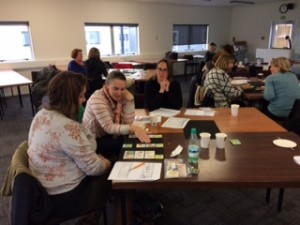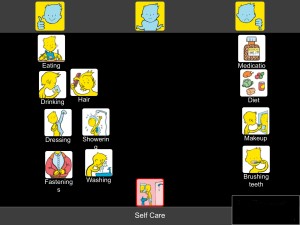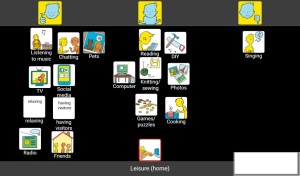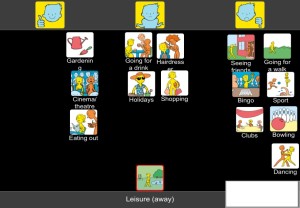Talking Mats is at its heart a Person Centred approach and makes this abstract concept real for practitioners and accessible to more people.
The skills we teach in our training are core to its values:
- Being explicit about the purpose of the conversation
- Using open questions
- Affirmation
- Active Listening
- Personalising
- Summarising
- Clarification
- Acknowledging that this is the persons view today and it is likely to change with time
‘ To improve the lives of people with communication difficulties by increasing their capacity to communicate effectively about the things that matter to them’
Our vision statement matches what is quoted in the introduction of the new Core Skills framework ‘Person-Centred Approaches’ produced by NHS Health Education England, Skills for Health and Skills for Care http://www.skillsforhealth.org.uk/news/latest-news/item/576-new-framework-to-promote-person-centred-approaches-in-healthcare
Talking Mats foundation training gives practitioners a tool to turn the values expressed in this powerful document into practice Read how one health authority made this a priority http ://www.talkingmats.com/person-centred-approach-to-health-planning
To support your organisation evidence they are using a Person Centred Approach look at our website www.talkingmats.com or contact info@talkingmats.com
This story, which highlights the importance of finding out what really matters to people, was shared by one of the staff attending the second day of an enhanced Talking Mats training course. She works in a NHS facility for people assessed as needing hospital-based continuing care.
I was working with Bill (not his real name) who is a man with severe cognitive impairment resulting from a head injury and stroke. He was very angry and agitated and we couldn’t work out what was wrong. At times he was physically aggressive when we couldn’t understand him.
One day he drew a picture of a rabbit and was very insistent about it but we didn’t know what it meant. We contacted his sister about him being angry about a rabbit. She asked around to other family members and friends but no one could think what it meant.
Bill continued to draw a rabbit and then other pictures including money and TV so I made an improvised Talking Mat using his drawings as the options and began trying to find out what really mattered to him. I gradually connected that the TV was about about programme called Dickinson’s Real Deal (a TV programme about antiques) and that in the past Bill had had an ornament of a rabbit which he thought was worth a lot of money.
We phoned his sister again about a possible rabbit ornament and she then remembered that he had collected figurines in the past. She finally discovered the rabbit in her garage.
Once we were able to reassure Bill that his rabbit was safe his frustration lessened,he was much less angry and became more settled.
This lovely story shows us how important it is to never assume that someone is just ‘being difficult’ but that if we can try to find out what really matters to them we can make a huge difference to their lives and ours.
Huge thanks to all the practitioners who have sent us guest blogs. We selected our 10 favourite guest blogs…in no particular order!
- Talking Mats to support children who stammer Kirsten Taylor, Speech and Language Therapist tells a moving story about how finding out what was upsetting a boy with a stammer helped to implement change.
- Hearing the voice of the child Emma Atkiss, Senior Educational Psychologist, shares her findings from the Wigan Pathfinder project reporting that using a Talking Mat helps to meet the 5 criteria of Shier’s model of participation.
- Talking Mats for capacity assessments in people with ASD/LD Ruth Spilman, Senior SLT from The Cambian Group, shares practical tips on assessing capacity.
- Castle hill school supports pupil voice Jenna McCammon, SLT and Rebecca Highton, SLT Assistant, tell 3 inspiring stories using TMs in: selective mutism; safeguarding and motivational interviewing.
- Supporting Looked After Children to have their say Karen Wilson, Principal Teacher for children with additional support needs in a mainstream secondary school shares her experience of using TMs to give young people a stronger voice in making decisions affecting them.
- Hearing the voices of Looked After Children Rachel Clemow, Head Teacher and Donna Wood, Education Support Worker, report that Talking Mats has enabled children to express their thoughts and views in a safe, neutral environment.
- Talking Mats and Mental Health Carla Innes, Clinical Psychologist for learning disability from Healthy Young minds Stockport talks about the impact of TM training on the whole team.
- Mummy I don’t want to go to nursery today read about how using a Talking Mat might shed some light on why a 4 year old was upset at the thought of going to nursery.
- How do you feel about starting school? The story of 4 year old twins and their thoughts about starting school.
- Sibling Attitudes Prof Juan Bornman from Pretoria in South Africa publishes a report on a study carried out with 27 typically developing children who have a younger sibling with a severe speech and language disability.
If you have been inspired and are not yet trained to use Talking Mats – come along to one of our training courses.
The Talking Mats Keeping Safe Learning Disability projects ends but a resource that promotes safeguarding and well-being continues.
The Keeping Safe Talking Mat provides a structured framework to ask someone ’How’s your life going? We are grateful to the Scottish Government Keys to Life monies for funding the trials. Impact of use of the resource was gained by practitioners sending in examples of their use of Keeping Safe, and the outcomes and actions from the Mats were themed.
The resource has been shown as a helpful way to
- discuss new information (89%). Staff frequently commented that using the Mats revealed things they had not known previously.
- discuss and resolve fears (84%) . It provided a framework that was supportive for those more difficult and or sensitive conversations e.g.’ Usually when she expresses her feelings she can get either upset or angry. She did not get upset or angry at any point through doing the Talking Mats, although the subject and things she was saying was at times difficult issues.’
- support thinking (89%) ‘It helps with memory and attention as she has something visual to keep her focused.’
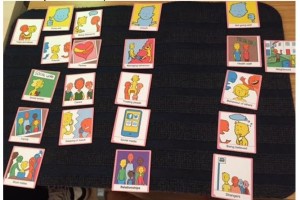
Initially many staff thought using the resource would take too much time but in fact were really surprised to find how much quality information they got in a short space of time. A cost benefit analysis demonstrated that using the Keeping Safe resource is cost effective for organisations i.e. for every £1.00 an organisation spends on the training and the resource, the potential financial benefit to the organisation is £23.00. We believe this is because the Mats create a powerful listening space and so that issues can be addressed timeously and not spiral out of control. This has not only a financial benefit but also a return in terms of an individual’s well-being and access to local non specialist services.
Although this resource was developed with adults with a learning disability, several people have reported that they have found it useful with other client groups e.g. adults with acquired neurological disorders and young people particularly with mental health issues .
If you want to read in more detail about the design process behind the resource then please read this journal article published in the Tizard Learning Disability Review More Than Pictures TLDR 2017
Involving people with a learning disability in service evaluation is both essential and challenging.
Maria Lavery speech and language therapist, and her colleagues in North and South Lanarkshire are using Talking Mats to get feedback about the service they deliver for people with a learning disability . They want to find out about what people feel they do well, and what could be done differently. In addition they have placed a suggestion box at the entrance to their building, but want to involve everyone who is connected with their service – clients, family, carers various multi-agency colleagues and are carrying the review out over a 6 month period.
The analysis and learning will be used to inform the Speech & Language Therapy work plan and support the future direction of the service.
Talking Mats has been used successfully to evaluate Augmentative and Alternative Communication services and the resource for this is available on our website http://www.talkingmats.com/wp-content/uploads/2013/09/AAC-service-Evaluation-script-and-symbols.pdf
Laura Holmes was pleased to meet up with Rachel Clemow, Head Teacher and Donna Wood, Education Support Worker who work for the Virtual Schools Team in Wigan to find out about the impact of Talking Mats training.
Donna accessed a Talking Mats Training last year delivered by a Talking Mats accredited Trainer in Wigan Educational Psychology service and quickly put her training into practice with the children that she works with, using the Consulting Children and Young People – Primary resource pack. Other members of the team soon recognised the potential benefits of introducing this approach themselves, and so, in April 2017, a further 15 members of the Virtual Schools Team received Talking Mats training.
Looked After Children can often struggle to express their thoughts and feelings, often as a result of their situation/ circumstances. This can be further compounded if they also present with speech, language and communication difficulties. There is a higher risk of such difficulties within the LAC population (Cross 1999 ).
Often there are many professionals involved with a Looked After Child, all asking a wide variety of questions, some of which can be highly personal and/or emotive in nature. The team have observed that children will sometimes end up giving answers which they think the listener wants to hear, rather than answers which reflect their true feelings/views – or the child may withdraw from the process entirely. Consequently, it can be very difficult to ensure that the true ‘voice of the child’ is being heard. Sometimes the children themselves struggle to understand what their own feelings are – often the topics and questions can be complex and involve abstract concepts.
Rachel and Donna report that the Talking Mats approach has had a big impact on their communication style when working with the children on their caseloads, and has enabled children to express their thoughts and views in a safe, neutral environment. Some of the comments they made about Talking Mats were that it:
– Enables the listener to get to know a child quicker and more easily as there is no pressure/expectation of the ‘thinker’ – it is a child/’thinker’ led approach.
– Provides way of supporting the child to open up to express their views and feelings, even if they have previously been hard to engage – and for the child to develop better insight into their own feelings.
– Helps to avoid the possibility of adult/listener misinterpretation of what the child is trying to communicate.
– Enables the child to focus on pictures – which appears to result in the child being more comfortable in expressing their own views and feelings – as opposed to what the child thinks the listener wants to hear.
– Provides a holistic view of the child – which can support target setting and planning at key stages for that child, for example, transition to High School.
– Gives the child something they can be successful at – there are no ‘wrong’ answers.
Donna shared a great example of how Talking Mats helped a young girl to describe an issue at home which she had not shared with any carers or school staff previously. The child placed the ‘home’ option symbol on the ‘not happy’ section of the mat then began to whisper to Donna explaining the reason why. This resulted in Donna being able to share the information with school staff and social care, consequently, the issue was resolved.
Services, organisations and schools in Wigan are already using the Talking Mats approach as a result of widespread training delivered by our Accredited trainers in the Educational Psychology Team. This provides a great example of how using Talking Mats across agencies can really help a whole area to become more child/ young person led.
The Virtual Schools team are now recommending the Talking Mats approach to other agencies working with the Looked After Children on their caseloads, such as adoption and fostering services.
If want to access the training then there are Talking Mats foundation courses run regularly in London, Stirling , Manchester and Newcastle . Once you have attended a foundation training and gained experience you can apply to become an accredited trainer .
This is the second blog about Lois and Nicki’s amazing visit to Australasia – this time theirTalking Mats trip to New Zealand.
The view flying into New Zealand was dramatic. We looked down on a beautiful range of snow topped mountains glistening in the clear blue sky as our plane flew towards Christchurch. Our first stop was the South island for a foundation training organised by Talk Link. Our second foundation training was in Auckland in the North Island. At both places we had a fantastic group of interested practitioners who really engaged with how Talking Mats could be used and began thinking creatively about how they would apply in their work place .This included:
• Involving thinkers in decisions about the their alternative and augmentative communication and getting feedback on what works for them
• Exploring its value for young people in the youth justice system to support them to express their views and be a tool for increasing engagement
• Exploring how Talking Mats could be adapted to make them more accessible and culturally accepted to the Maori community
• Involving children in their education planning
We were really pleased that Talk Link also sent 3 staff to the accredited training course in Australia. This means that there will be increased access to Talking Mats Foundation training in New Zealand for the future. Our experience is that accredited trainers provide leadership that helps organisations embed Talking Mats into practice. Thanks to Ann Smaill for all her organising and support for both our Foundation and Accredited courses.
And our leisure times were special too. We had a trip on the Christchurch Gondola to see the stunning Banks peninsula; we experienced the hope and resilience of Christchurch following the earthquakes in 2010 and 2011. In Auckland we saw a thought provoking Maori exhibition and last but not least we loved our weekend of rest and relaxation on the very special island of Waiheke. The locals thought us mad to swim in the sea their autumn but we loved it!
More information
Click for more information if you want to find out about
Five short stories from our recent accredited training course in Stirling.
- A looked after child was unhappy but no one knew specifically why. Using the Talking Mats, she indicated that she was upset by the weekly phone call with her mother because it always happened when it was her playing time. The time of the call was moved to just before her bedtime but this resulted in bad dreams. The time of the call was finally moved to Saturday afternoon which helped her settle and reduced her distress.
- Talking Mats was used with an Iraqi boy who had come to England via Libya, Italy and the jungle camp at Calais. When he picked the symbol of a waiting room he indicated that despite all she had been through he really liked this because it reminded him of all the children in his family and made him happy.
- A 76-year-old man with a learning disability disclosed that he had been attacked and suffocated by his upstairs neighbour one week previously. It was only when he used the Talking Mats that he disclosed to anyone what had happened.
- A lecturer usually used quantifying measuring with her students to find out how they were managing their studies. Instead she used Talking Mats to find out how they were coping with their work life balance. One student told her that she was managing fine except that her pet rabbits always escape under the bed and it takes her a long time to get them back out so she does not let them out very often!
- Talking Mats was used with a man who had had a stroke and had to go into residential care because his family could no longer look after him. They were very worried that he was unhappy with the new care set up. He was able to show with the Talking Mats that he was happy about everything except that he was not given enough time when he went to the toilet. Once the staff realised this they then gave him more time which resolved the situation and reassured his family.
Please send us your Talking Mats stories – we love hearing them.
We’re always amazed to hear from people about the variety of topics they cover using Talking Mats –from how someone is managing their self care or domestic tasks, to arranging a wedding, or thinking about whats important at a funeral.
As a communication tool Talking Mats maximises a person’s capacity to reflect on a topic and express their view. It gives confidence in decision making.
Here are some other topics we’ve heard about recently.
- As a conversation tool in class
- Pupil voice in school improvement plan
- Client contribution to meetings and review day placement
- Respite
- Operations e.g. gastrostomy
- Health
- Postural management
- Where to live
- Childs opinions in relation to GIRFEC
- Respite feedback/choices
- SW assessments
- Choices available within service
- Going somewhere new
- Transitions
- Problem solving ie horse riding, identifying the problem
- Eating and Drinking
- Keeping Safe
- Social Media
What do you want to talk about? There is no limit!
We are now half way through our project, funded by The Health and Social Care ALLIANCE Scotland, whose overall aim is to empower people with a range of long term conditions, with and without additional communication difficulties, to self-manage their own health and well-being by using Digital Talking Mats.
Participants
We have carried out all the initial visits and 16 follow-up visits and participants are sending in their completed mats, choosing whichever topics they want from the digital Health and Well-being resource. At the time of writing this blog we have received 137 completed mats.
We have received very positive feedback with many examples of how people are using the Digital Talking Mats to self-manage.
Here are 3 examples:
One participant with learning disability has diabetes. Through using the Digital Talking Mats she has stopped buying takeaways every night and is now buying M&S ‘Balanced for You’ meals. This is a huge step forward for her as she refused to discuss healthier eating before.
A man with early onset dementia has identified that he used to enjoy singing and has decided for the first time in his life to join a choir. This is not something that had come up in conversation before. Despite the diagnosis of dementia he has realised that he is still keen to try new things.
The wife of a man with severe aphasia said ‘This (Leisure away) has highlighted how few things he can do away from home. We discussed this but can’t see how we can change the situation.’ However at the second visit he used the same mat and indicated that he had been thinking about his mobility and was about to start swimming and a fitness class.
We already have an increased awareness of the meaning of self-management as we observe how participants are using the Digital Talking Mats to think about their situation, state their own views and share them with carers/support workers. We are also noticing that there is a shift in some relationships as the carers/support workers realise that the person with the long term conditions can make decisions and express their own views rather than having decisions made for them.
 Online training login
Online training login 

